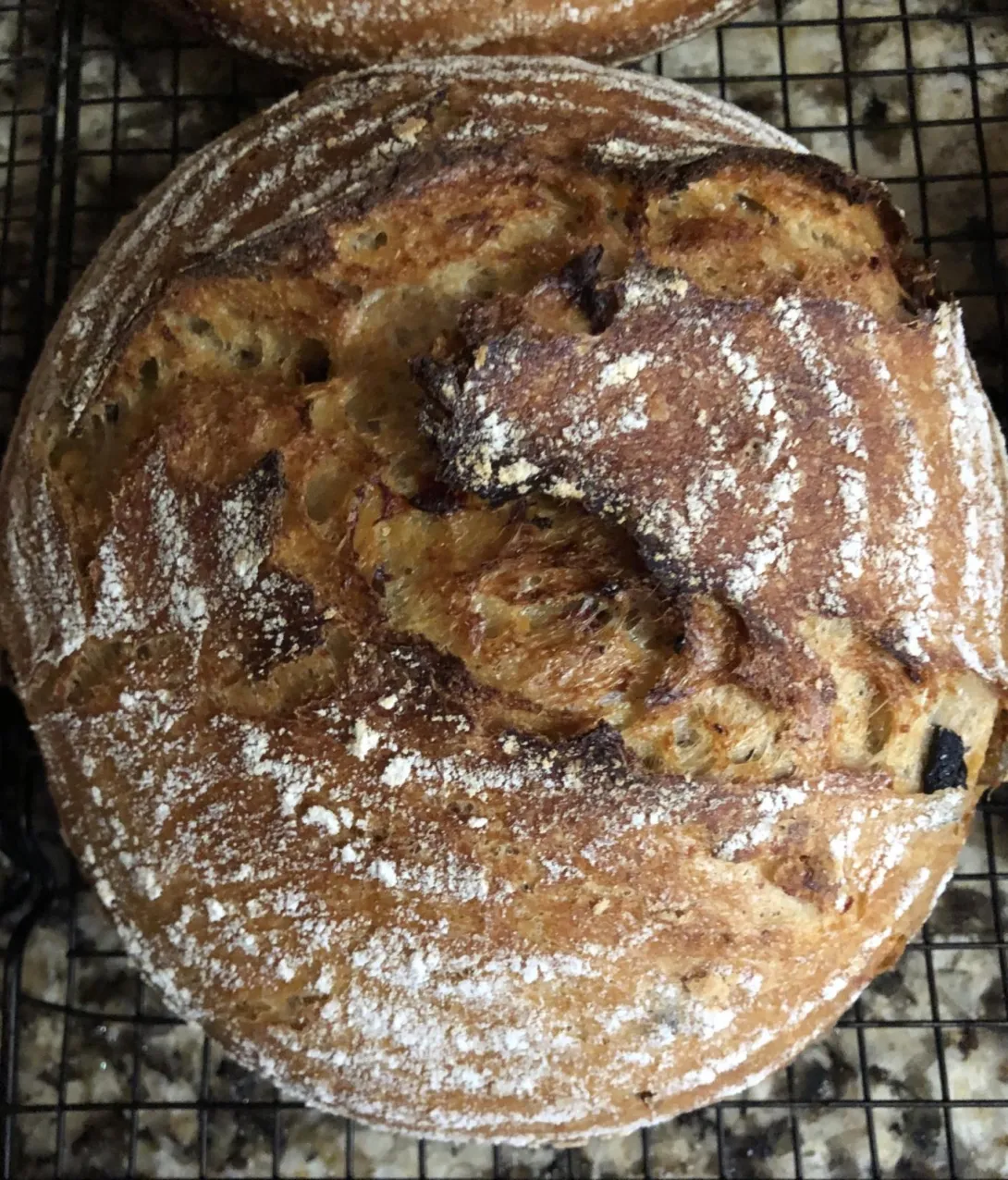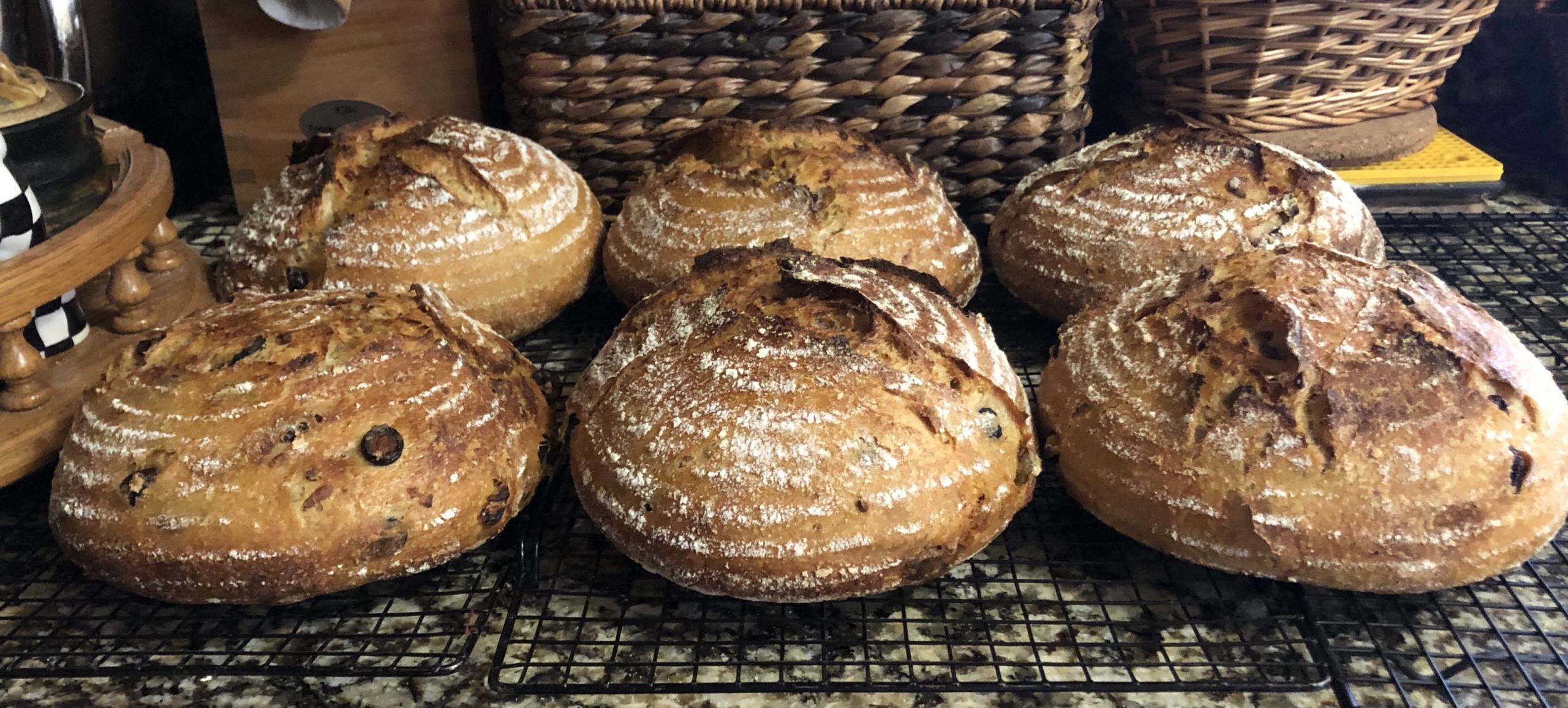
One of my customers requested a savory loaf with feta and olives so I made a repeat of this one but by using James (Ciabbata)’s method. I was going to try to dump all the add-ins at the beginning but I had second thoughts because of the oily nature of the extras. Then I decided that I could add the extras while laminating the dough which is something I’ve never done (the lamination). Experimentation is good, right? So here goes…
Recipe:
Makes 3 loaves
Add-ins:
154 g of mixed olives (55 g Kalamata, 52 g Manzanilla and 47 g Black- sliced and pitted)
90 g Feta, crumbled
28 g Sun-dried Tomatoes in oil, drained and chopped (reserve oil)
54 g Flame roasted red peppers, drained and chopped
16 g of oil from the sun-dried tomatoes
Main dough:
300 g of durum berries
50 g of rye berries
700 g of strong baker’s unbleached flour
725 g of filtered water
10 g Old Bay seasoning
15 g Pink Himalayan salt
250 g levain (procedure is in recipe and will need additional unbleached flour)
Two afternoons before:
- Take 2 g of refrigerated starter and feed it 4 g of filtered water and 4 g of any kind of wholegrain flour. Let sit at room temperature until bed time.
Two nights before:
- Feed the levain 20 g of water and 20 g of wholegrain flour. Let that rise at cool room temperature overnight.
The morning before:
- In the morning, feed the levain 100 g of filtered water and 100 g of unbleached flour. Let rise until doubled and then put into the fridge until the next day.
- Mill the Durum and rye berries. Place the required amounts of Durum and Rye flour in a tub, and add the unbleached flour to it.
- Add the old Bay Seasoning and the salt to the tub. Cover and reserve for the next day.
Dough Making day:
- In the morning, take the levain out of the fridge, give it a good stir and place in a warm spot (oven with the light on) for a couple of hours. After about 5 hours, the levain should be quite bubbly. It won’t have doubled but should have risen about 75%.
- When the levain is nice and bubbly, put the filtered water in a stand mixer’s bowl and add the levain (levain should float), and the flours from the tub. Mix on the lowest speed until all the flour has been hydrated and everything is homogeneous. This takes about 3-4 minutes. Place dough in a lightly oiled tub. Let the dough rest for 45 minutes in a warm spot (oven with the light on and the door cracked).
- Give the dough one set of coil folds and let rest for 30 minutes.
- Take the dough out of the tub and place it on a damp counter. Going all around the dough repeatedly, gently stretch it out from the middle out as far as it will go without tearing. Make sure to keep your hands wet. Sprinkle a third of the add-ins over the middle third of the dough, fold up one side over the add-ins, sprinkle another third of the add-ins over the folded portion and fold the last third over the middle. Sprinkle the rest of the add-ins on top and do a triple letter fold in the other direction until you have a nice package. I folded the dough in half again to make the package smaller. Place back in the tub. Let rest 30 minutes.
- Do another two sets of coil folds with a 45 minutes interval.
- Then let the dough rise to 30%. With it being a cool day, the dough took a couple of hours to get there even though I kept it in a warm spot. I find it fascinating how the dough knows what the outside weather is like.
- Tip the dough out on a bare counter, sprinkle the top with flour and divide into portions of ~800g. Round out the portions into rounds with a dough scraper and let it rest 15 minutes.
- Do a final shape by flouring the rounds and flipping the rounds over on a lightly floured counter. Gently stretch the dough out into a circle. Pull and fold the third of the dough closest to you over the middle. Pull the right side and fold over the middle and do the same to the left. Fold the top end to the center patting out any cavities or big bubbles. Finally stretch the two top corners and fold over each other in the middle. Roll the bottom of the dough away from you until the seam is underneath the dough. Cup your hands around the dough and pull towards you, doing this on all sides of the dough to round it off. Finally spin the dough to make as tight boule as you can.
- Sprinkle half rice/half AP flour in the bannetons. Place the dough seam side down in the bannetons. Cover with plastic bowl cover or shower caps. Let rest for a few minutes on the counter and then put to bed in a cold (38F) fridge until the next day.
Baking Day
- The next morning, heat the oven to 475F with the Dutch ovens inside for 45 minutes to an hour. Then take the loaves out of the fridge.
- Turn out the dough seam side up onto a cornmeal sprinkled counter. Place rounds of parchment paper in the bottom of the pots, and carefully but quickly place the dough seam side up inside.
- Cover the pots and bake the loaves at 450 F for 25 minutes, remove the lids, and bake for another 22 minutes at 425 F. Internal temperature should be 205 F or more.
The oven spring isn’t what I hoped for. They aren’t completely flat but then again, there is a fair amount of add-ins to weigh the dough down in this particular recipe.

- Danni3ll3's Blog
- Log in or register to post comments
unusual add ins for sure and lots if the:-) The flatness should be made up with additional flavor! Should look different since feta doesn't melt! I like the darker loaves the best1
Lighter when I bake them the same amount of time as the others. I’ll have to keep track of which ingredients might cause that although I know anything with any sugar will cause a darker crust but some do go dark even without honey in them
They sound like they will be delicious Danni. How did you like using a lamination to add the inclusions? I really enjoy doing it this way, Hopefully you will see how well it helps evenly distribute the inclusions.
That ended up with an awful lot of the add-ins. It was just the one batch thank goodness. It is definitely an interesting way to develop the gluten. I’m not sure that I’m going to continue though as I’m going to go back to doing a true autolyse and then adding the salt, yogurt and levain in the mixer. I might as well put the add-in at the end of that as well. Less of a mess.